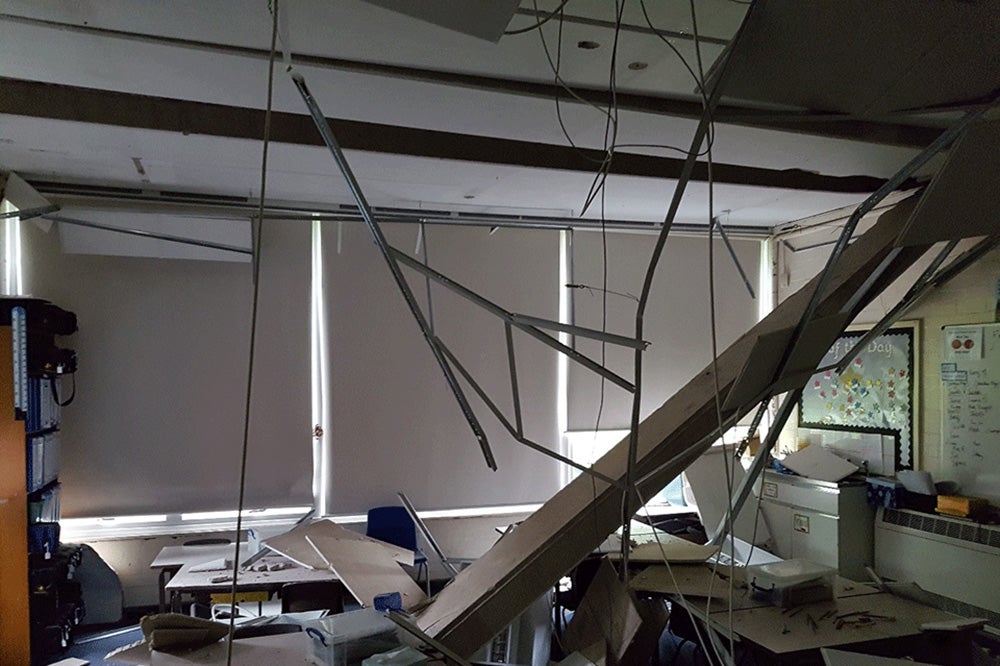The RAAC concrete ‘ticking time bomb’ that schools were warned about years ago
In 2017, a committee was asked to investigate the suitability of RAAC after a school roof collapsed

Your support helps us to tell the story
From reproductive rights to climate change to Big Tech, The Independent is on the ground when the story is developing. Whether it's investigating the financials of Elon Musk's pro-Trump PAC or producing our latest documentary, 'The A Word', which shines a light on the American women fighting for reproductive rights, we know how important it is to parse out the facts from the messaging.
At such a critical moment in US history, we need reporters on the ground. Your donation allows us to keep sending journalists to speak to both sides of the story.
The Independent is trusted by Americans across the entire political spectrum. And unlike many other quality news outlets, we choose not to lock Americans out of our reporting and analysis with paywalls. We believe quality journalism should be available to everyone, paid for by those who can afford it.
Your support makes all the difference.Last year, construction experts warned RAAC was a “ticking time bomb” and estimated around “half” of the four million non residential buildings in the UK were affected by the material.
Now, more than 100 schools, nurseries and colleges in England have been told by the government to close classrooms and other buildings that contain aerated concrete that is prone to collapse.
So when was the material first used, when was it first flagged as a danger, and what was done about it?
When was the material first used?
Reinforced autoclaved aerated concrete (RAAC) was first used by municipal architects between the 1950s and 1990s for the construction of offices and schools, as well as other buildings, like hospitals, according to the Local Government Association.
As of 30 August 2023, there were 156 educational buildings built with RAAC, records show. Only 56 of these had “mitigations” in place, meaning engineers had deemed sites were not a risk due to areas being closed down or reinforced with other materials.
When was RAAC flagged as a danger?
The lightweight concrete, which is a “porous” material, has long been recognised as having “limited durability”, according to the LGA. The Government has been aware of public sector buildings constructed with the material since 1994.
2017
The Standing Committee on Structural Safety was asked to investigate the suitability of the material after a school roof collapsed, although it is not clear which school this was.
2018
Another roof collapsed at a Singlewell Primary School in Kent. It happened above the school staff room, also damaging toilets, ICT equipment and an administration area. The collapse prompted Kent Council to write to other local authorities warning them to check for RAAC in their schools.
2019
A structural engineer investigating on behalf of SCOSS began to “frequently” encounter RAAC planks that weren’t fit for purpose and warned all those installed before 1980 should be replaced.
RAAC planks were becoming “more defective with time”, the report found. It said: “It appears that not all of these have been identified, so structural engineers and building professionals need to be aware of the situation and, when possible, check for RAAC on large flat roofs built around the 1960s-80s.”
What did the Government do?
2018
The Government published guidance for schools about the need to have adequate contingencies in place for the eventuality that RAAC-affected buildings need to be vacated at short notice, according to the DfE.
But the information for schools applying for grants for construction improvement funding round said that “not all RAAC is dangerous”, according to some reports.
2022
The Department for Education sent a questionnaire to all responsible bodies, asking them to provide information to help us understand the use of RAAC across the school estate.
2023
Now, the Government is “less confident” that buildings constructed with RAAC should remain open without extra safety measures. New guidance advises schools and colleges to close any buildings known to contain RAAC.
The DfE has contacted 104 “settings” where RAAC is confirmed to be used in construction without mitigations in place, and has asked them to vacate these buildings.
Around 24 schools will have to fully close their doors and find alternative teaching spaces, it is understood. In total, more than 100 schools have been told to find emergency accommodation until classrooms are made safe.



Join our commenting forum
Join thought-provoking conversations, follow other Independent readers and see their replies
Comments